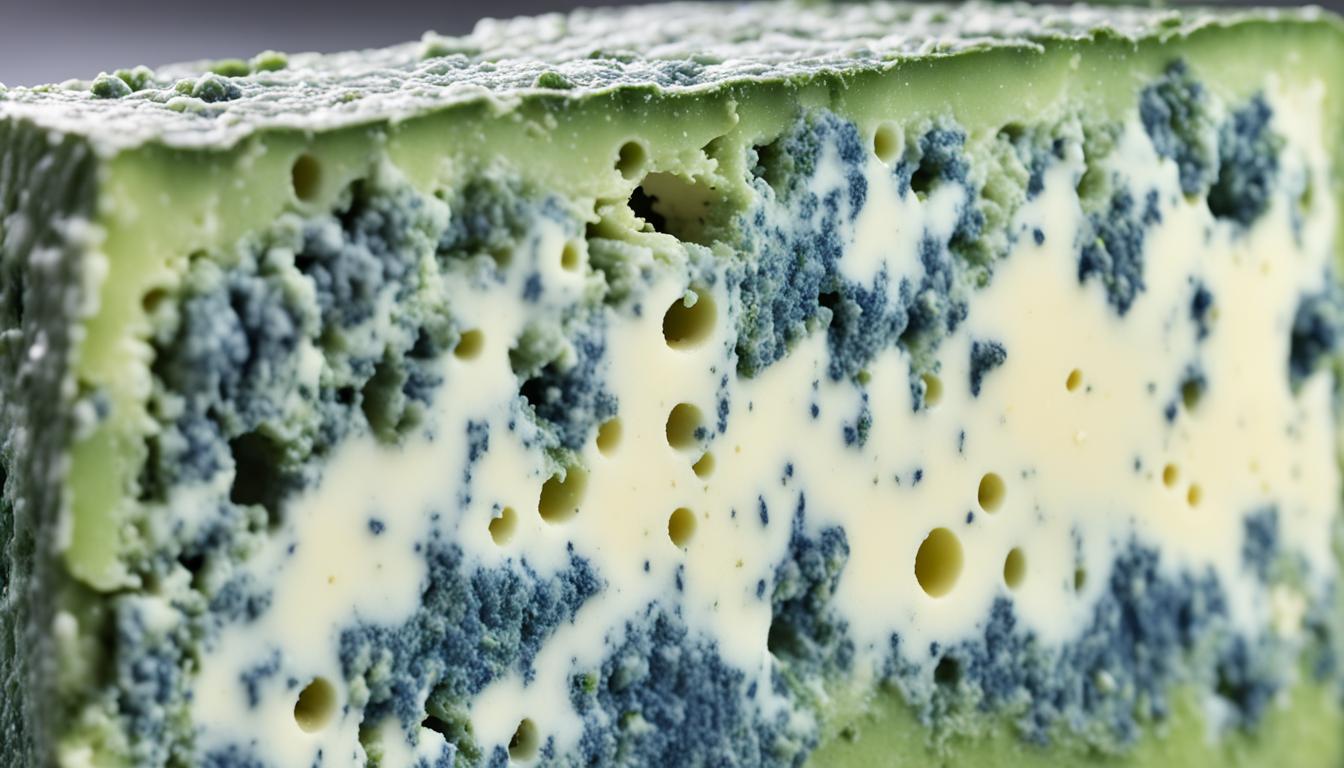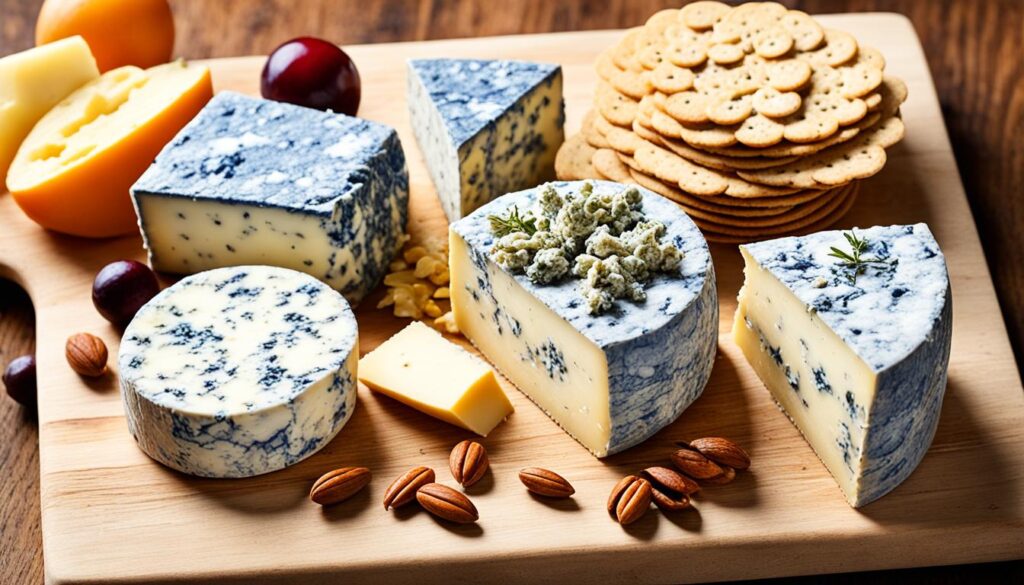
Mastering the Art of blue cheese Mold
Welcome to the fascinating world of blue cheese mold! If you’re a culinary enthusiast looking to elevate your cheese-making game, understanding the secrets of blue cheese mold is essential. Not only does it contribute to the distinct flavor profile of blue cheese, but it also enhances the overall taste experience.
Blue cheese mold acts as a flavor enhancer, infusing the cheese with its unique tanginess and earthy undertones. The delicate balance of flavors and textures it creates is what makes blue cheese a beloved choice for cheese connoisseurs around the world.
From the vibrant blue veins that streak through the cheese to the creamy richness that lingers on the palate, blue cheese mold is a key ingredient in creating these delightful characteristics. Whether you’re a cheese lover or an aspiring cheese maker, mastering the art of blue cheese mold is a journey that will bring a new depth of flavor to your culinary creations.
Key Takeaways:
- Blue cheese mold is a flavor enhancer that adds tanginess and complexity to the cheese.
- The unique characteristics of blue cheese mold contribute to the distinct flavor profile of blue cheese.
- The art of blue cheese mold involves achieving the perfect balance of flavors and textures.
- Understanding blue cheese mold opens the door to experimenting with homemade blue cheese varieties.
- Embrace the art of blue cheese mold to elevate your culinary creations with bold and complex flavors.
The Science Behind Blue Cheese Mold
Blue cheese lovers appreciate its distinct and complex flavor profile, which is largely attributed to the presence of blue cheese mold. In this section, we will unravel the fascinating science behind this crucial ingredient in the cheese-making process.
Blue cheese mold, scientifically known as Penicillium roqueforti, plays a significant role in the development of the cheese’s characteristic blue veins and unique taste. But how does this mold contribute to the cheese’s flavor and texture?
The blue cheese mold introduces enzymes that break down the proteins and fats in the cheese, resulting in the formation of the distinct flavors and textures associated with blue cheese.
There are several types of blue cheese mold strains, each offering its own set of characteristics and flavors. The most commonly used strains include Penicillium roqueforti, Penicillium glaucum, and Penicillium camemberti. These molds create the blue veins and impart the tangy, earthy, and sometimes spicy notes that define blue cheese.
To thrive and impart its unique qualities, blue cheese mold requires specific conditions during the cheese-making process. The ideal temperature range for blue cheese mold growth is between 50°F to 60°F, with a humidity level of around 95%. These conditions create an optimal environment for the mold to develop and interact with the cheese to achieve that distinct blue cheese flavor.
During the cheese-making process, the blue cheese mold is introduced by carefully piercing the cheese with sterilized needles or injecting it with the mold culture. The mold then grows within the cheese, creating the characteristic blue veins and contributing to the overall flavor development.
Understanding the science behind blue cheese mold allows cheese makers and enthusiasts alike to appreciate the intricate artistry involved in crafting this beloved cheese. By mastering the conditions and techniques necessary for blue cheese mold growth, cheese artisans can create exceptional blue cheeses with a variety of flavors and textures.
Blue Cheese Mold Facts
- Around 350 varieties of blue cheese exist, each with its own unique characteristics influenced by the specific blue cheese mold strain used.
- The cheese-making process can take anywhere from a few weeks to several months, depending on the desired flavor development and maturation.
- Blue cheese mold is not only found in blue cheeses but can also be used to create other varieties like Roquefort and Stilton.
So, the next time you savor a delicious piece of blue cheese, remember that behind its captivating flavors and textures lies the intricate science of blue cheese mold.

Crafting Blue Cheese with Mold
Discover the art of crafting blue cheese using mold. Blue cheese is a beloved variety known for its distinct flavor and creamy texture. The secret behind its unique taste lies in the mold that develops during the cheese-making process. Let’s explore the different types of blue cheese varieties, the techniques for introducing the mold, and the factors that contribute to its development and maturation.
Types of Blue Cheese Varieties
Blue cheese comes in a variety of forms, each with its own distinct characteristics. Some popular blue cheese varieties include:
- Gorgonzola: Hailing from Italy, Gorgonzola is a rich and creamy blue cheese with a tangy flavor.
- Roquefort: A French cheese with a crumbly texture and a sharp, salty taste.
- Stilton: An English blue cheese known for its mellow and earthy flavor.
- Maytag Blue: A classic American blue cheese with a smooth and buttery consistency.
Introducing the Mold
The mold responsible for the characteristic blue veins in the cheese is Penicillium Roqueforti. It is introduced during the cheese-making process in the form of spores. These spores, combined with the right conditions, create the perfect environment for mold growth.
Traditionally, blue cheese is made by piercing the cheese wheels with needles to allow oxygen to reach the interior. This oxygen supply stimulates the growth of mold and helps develop the distinct flavors and textures.
Factors Affecting Development and Maturation
Several factors influence the development and maturation of blue cheese:
- Aging time: Blue cheese requires a specific aging period to allow the mold to fully enhance the flavors. The aging process can range from a few weeks to several months or even years.
- Humidity and temperature: Maintaining the optimal humidity and temperature during the aging process is crucial for mold growth and flavor development.
- Maturing environment: Blue cheese is typically aged in caves or temperature-controlled rooms to provide the ideal conditions for mold growth and flavor development.
Mastering the craft of blue cheese-making requires careful attention to these factors to achieve the perfect balance of tanginess and creaminess in your homemade blue cheese.

Conclusion
Throughout this comprehensive guide, you have gained a deeper understanding of the fascinating world of blue cheese mold and its significance in the culinary realm. Armed with this knowledge, you can now confidently embark on a journey of experimentation with blue cheese in your cooking, taking your dishes to new heights with its bold and complex flavors.
Embracing the art of blue cheese mold opens up a realm of possibilities for creating extraordinary culinary experiences. Whether you’re incorporating it into a gourmet salad, melting it into a creamy pasta dish, or simply enjoying it on a piece of crusty bread, blue cheese adds a level of sophistication and depth that is unrivaled.
So, go ahead and savor the delightful results that blue cheese mold brings to your taste buds. With its tanginess and creamy texture, it adds a unique twist to your favorite recipes and elevates your culinary creations to a whole new level. Elevate your cooking game and let blue cheese become your flavor-enhancing secret weapon in the kitchen.




